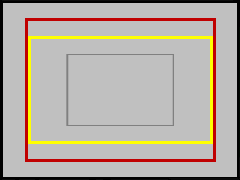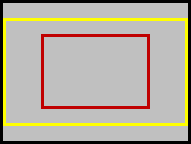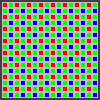Optura Watchdog
Introduction
|
> top of page < |
Canon Optura 40 vs. Elura 70 Comparison
Part Two by Chris Hurd
Megapixel CCD · 16:9 Display · Color Filter
Digic DV · Audio Control · Lens · BatteryThis second half of this article continues now with a look inside the Optura 40 and Elura 70, revealing some significant differences in image quality, color accuracy and usability features. The Optura is sold at a higher price for a reason; it performs better and offers some options not found on the Elura. In the first half, external differences were examined. Here now are some of the most important internal feature set comparisons.
Megapixel CCD's, 2.2 vs. 1.3
The image sensor in both camcorders is a CCD (charge-coupled device), which is an analog, monochromatic array of light-sensitive pixels. The Optura 40's CCD is composed of 2.2 million pixels; the Elura 70's CCD has 1.3 million pixels. These sensors differ also in size, with the Optura's larger chip stated as 1/3.4 inches and the Elura's smaller chip stated as 1/4.5 inches. Expressing fractions with a decimal point can tend to be a bit confusing. In traditional terms, the Optura's 1/3.4" CCD might also be stated as 0.294 inches, just a shade under 19/64" or roughly 7.5 millimeters. Likewise, the Elura's 1/4.5" CCD could be stated as 0.222 inches, just a hair over 7/32" or roughly 5.6 millimeters. Ultimately any CCD is always somewhat smaller than its given size anyway.
The left graphic represents the Optura's 2.2 megapixel 1/3.4" CCD.
The right graphic represents the Elura's 1.3 megapixel 1/4.5" CCD.
The graphics are roughly to scale with each other.Both image sensors have their pixel arrays layed out in a standard 4:3 aspect ratio. On the Optura 40's 2.2 megapixel chip, the total number of pixels in the array for making an image is 1632 x 1224, the entire usable spread of the CCD. This is the largest still photo size available in the Optura, and it translates to a maximum print output size of 8 x 10 inches, perhaps best optimized at 5 x 7 inches. On the Elura's 1.3 megapixel chip, the total number of pixels for a still photo is its maximum spread of 1280 x 960, translating to a maximum print output size of 5 x 7 inches, best at 4 x 6 inches.
The Optura and Elura use identical methods for achieving high resolution 16:9 widescreen recording. Both megapixel CCD's offer enough real estate in their pixel arrays to allow "native" 16:9 image aquisition. A wide slice of pixels is sampled from the middle of the CCD (in the Elura this is an edge to edge chunk from the center; see the yellow rectangles in the two CCD graphics above). The image size is 1280 x 720 pixels, in the proper 16:9 aspect ratio. Of course it must be recorded to DV cassette "legally" so it is squeezed down to 720 x 480 (otherwise it wouldn't be DV). On a widescreen HDTV set, the image plays back properly as 16:9. This method is much superior to the old way of cropping pixels, which tossed out valuable vertical resolution. Although these megapixel CCD's are made in the 4:3 aspect ratio, you can safely say that the 16:9 recording mode they offer is indeed "native" widescreen.
Standard 4:3 video recording is handled a bit differently between the Optura and Elura. While the Elura uses 690,000 pixels for normal DV tape recording, the Optura samples a much larger 1.3 megapixel chunk for the same purpose (see the red rectangles in the two CCD graphics above). This 1280 x 960 area is downconverted to "legal DV" at 720 x 480 (gray rectangle in left graphic above). The result of the conversion is more sampling points per pixel, producing a sharper image than conventional methods.
16:9 Letterbox Display
Here's a "better late than never" feature that's new on both the Optura and Elura models. Throughout Canon's previous history of DV camcorders, the flip-out LCD display has always shown a "squished" image when recording in 16:9 mode; an effect akin to watching a Spaghetti Western on late-night cable television, where subjects in the field of view appear tall and thin from the result of vertically stretching the 16:9 aspect ratio to fill the entire 4:3 display. Finally now, the Optura 40/30 and Elura 70/65 models show the 16:9 recording mode properly, with letterbox mattes above and below the image in the flip-out LCD display. Unfortunately this belated feature is not available on the older, more advanced Optura 300 and Xi models.
Primary Color vs. Complimentary Color
The Optura 40/30 models incorporate a primary (RGB) color filter, which is superior to the Elura 70/65/60's complimentary (CMY) color filter in terms of color accuracy. All CCD image sensors are monochromatic devices; they don't know what "color" is. The image sensor must assemble color information from a filter mask built onto the face of the CCD. Primary color filters provide red, green and blue values to the image sensor, which is basically the same way that camcorders using three CCDs are building color information. In fact, a single-CCD camcorder with an RGB filter will closely approximate the look of a 3-CCD camcorder. On the other hand, complimentary color filters provide cyan, magenta and yellow values to the image sensor. Traditionally this method provided better luminence and a higher signal-to noise ratio, but its color accuracy is inferior to the primary (RGB) color filtration process. Canon's proprietary signal processing algorithm limits these shortcomings, creating an ideal color solution. The single biggest difference in video quality between the Elura and Optura models is not the CCD imaging sensor itself, but the color filter in front of it. A primary color filter will produce the most accurate color (in the same ball park as a 3-CCD camcorder, in fact) and is always preferable to a complimentary color filter. This holds true for all camcorder manufacturers, not just Canon.
Digic DV Image Processor
The DSP (Digital Signal Processor) in most all current Canon DV camcorders is a proprietary technology that the manufacturer has branded as "Digic DV." Digic is a marketing brand which stands as a loose acronym for Digital Imaging Integrated Circuit. Basically, it's the central processing unit controlling all camera functions. Canon's video division has adapted this CPU for their camcorder side, giving it the Digic DV name for marketing purposes.
There are a couple of fundamental concepts which are important to understand about the Digic DV chip. First, it's the reason why Canon is able to use RGB color filtration without suffering the usual disadvantages of that method. The proprietary signal processing algorithms of the Digic DV chip eliminate the noise issues commonly associated with primary color filters.
Second, the Digic DV chip is actually a CPU with two brains. Since the Optura and Elura models are marketed as "hybrid" dual-function camcorders and digital still cameras, they must be capable of producing print-quality photos. However, images optimized for printing must be processed in a different way from images optimized for video. Conventionial digital video intended for a display on a living room television set or a broadcast video monitor requires 220 colors, while photos intended for hard-copy printing or for display on a computer monitor require 256 colors. Based on whether the image is being recorded to tape (for video) or to card (for photo), the Digic DV chip performs the requisite processing in the appropriate colorspace best suited for the final output of the image.
Audio Level Control
The Elura does not offer manual control of its stereo audio levels; they are always automatically adjusted by that camcorder's internal Automatic Gain Control circuit. However, the Optura 40/30 models feature the same manual audio control functions as their older Optura 300 and Xi siblings. A button behind the flip-out LCD display toggles the audio control from automatic to manual (while shooting in any video program mode accept the always fully automatic Green Box easy recording mode). When switched to manual audio control, the menu select wheel on the back of the Optura body is used to set the audio levels to the desired amount. An audio level bar graph will be visible in the lower right corner of the flip-out LCD display, marked at -40db, -12db and 0db. A single green line below denotes the manually set upper level limit, while pulsing white bars above indicate the actual current audio level. The Optura's stereo audio pair is ganged together; when the audio level is changed, it applies equally to both channels. There is no separate left and right audio control as there is on the Canon GL2.
Audio levels can be monitored via headphones while shooting in either Elura or Optura models. Access the menu, choose VCR Setup, and select the AV / Phones option. When the Phones option is set, the yellow AV input/output jack on the right front side of the camcorder will then function as a headphone jack for stereo audio output.
Lens
Although the lens front filter thread diameter for both the Optura 40 and Elura 70 is 34mm, it would be a mistake to conclude that the same lens is in both camcorders. They are in fact slightly different between the two models. The Optura 40/30 lens has twelve elements in ten groups, while the Elura 70/65/60 lens has ten elements in eight groups. However these two different lenses produce nearly the same field of view. The focal length of the Optura 40 in 35mm still photo equivalent terms is 50mm at the wide end to 700mm at extreme telephoto when recording in tape mode (39mm to 546mm in card camera mode). On the Elura 70, the field of view is almost identical to the Optura at the wide end; 50.5mm in 35mm still photo equivalent terms, to 909mm at extreme telephoto when recording in tape mode (37.9mm to 682.mm in card camera mode).
model optical
zoomlow
digitalhigh
digitalfocal
lengthmin. f/stop
wide / teleOptura 40 14x 56x 280x 4.8 - 67.2mm f/1.8 - f/3.0 Optura 30 12x 48x 240x 4.8 - 57.6mm f/1.8 - f/3.0 Elura 70 18x 72x 360x 3.5 - 63mm f/1.8 - f/3.4 Elura 65 16x 64x 320x 3.5 - 56mm f/1.8 - f/3.3 Elura 60 14x 56x 280x 3.5 - 49mm f/1.8 - f/3.1 The WA-34 wide-angle attachment included with the Elura 70 converts the field of view at the wide end to 35.4mm respectively (once again, in 35mm still photo equivalent terms). The WA-34 is not a zoom-through adapter, however. It works properly only when the lens is zoomed out all the way to full wide angle.
Image stabilisation is electronic (EIS) in the Optura 40/30 and Elura 70/65/60.
There is a built-in macro mode on all Canon DV camcorders. Zoom the lens out all the way to full wide angle and insure that there is enough light. With the lens on autofocus, you should be able to place an object within one centimeter from the lens and view it with perfect clarity.
Battery Endurance
There are four different batteries available for the Optura 40/30 and Elura 70/65/60. All of them are fairly small and none of them offer overwhelming endurance. Even the "double capacity" BP-2L14 will last barely an hour and a half in an Optura 40 with the LCD screen open under typical recording conditions, such as frequent starting and stopping and powering on and off. In fact, the operator's manual for both camcorder types states that actual recording times may be even lower than what's stated for "typical" in the chart below.
Optura 40/30 NB-2L NB-2LH BP-2L12 BP-2L14 Max. Rec. VF 70 min. 90 min. 145 min. 185 min. Max. Rec. LCD 55 min. 75 min. 120 min. 155 min. Typ. Rec. VF* 40 min. 50 min. 80 min. 100 min. Typ. Rec. LCD* 30 min. 40 min. 70 min. 85 min. Playback Time 85 min. 105 min. 175 min. 220 min. Elura 70/60/50 NB-2L NB-2LH BP-2L12 BP-2L14 Max. Rec. VF 95 min. 115 min. 200 min. 240 min. Max Rec. LCD 75 min. 90 min. 150 min. 190 min. Typ. Rec. VF* 50 min. 65 min. 110 min. 135 min. Typ. Rec. LCD* 40 min. 50 min. 85 min. 105 min. Playback Time 85 min. 105 min. 175 min. 220 min. Charging Time 110 min. 115 min. 180 min. 210 min. *Typical Recording Time: Approximate times for recording with repeated operations such as start/stop, zooming, power on/off. The NB-2LH is included with the Optura 40 and 30, and Elura 65 and 60.
The NB-2L14 is included with the Elura 70.As always, your mileage may vary. If you expect to be shooting in an area where AC power is not available or practical, then do yourself a huge favor. Include at least one, and preferably two BP-2L12's or 14's in your shooting kit. Always take the charger with you! And reserve the Optura's meager 2LH for emergencies. Finally, of course, you can't have too many batteries!
Back to Part One of this article.
Back to the Articles Menu
Thrown together by Chris Hurd
Please direct questions to the DV Info Net Community Forums.
Where to Buy: These dealers are authorized DV Info Net sponsors... | |||
|
|
|
|
|
|
|
|
Please support this site by making your purchases through them. Thanks! | |||
©1998-2008 DV Info Net
The Digital Video Information Network
San Marcos, Texas
Never trust a person who agrees with you. They're probably wrong.



